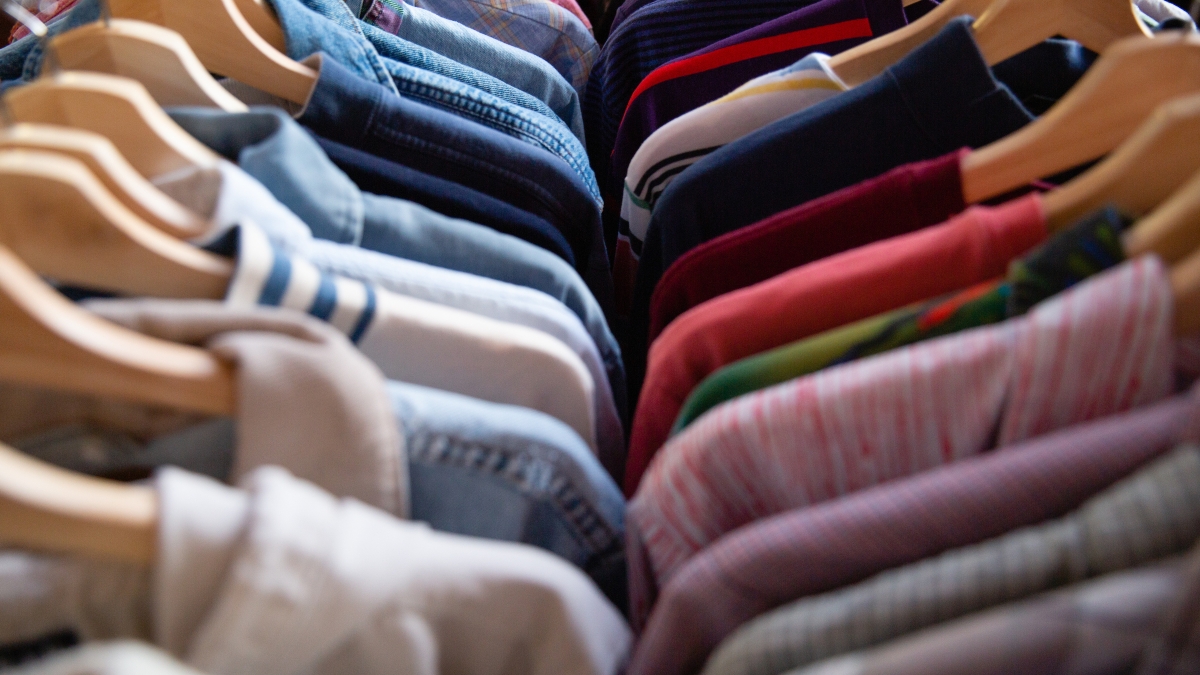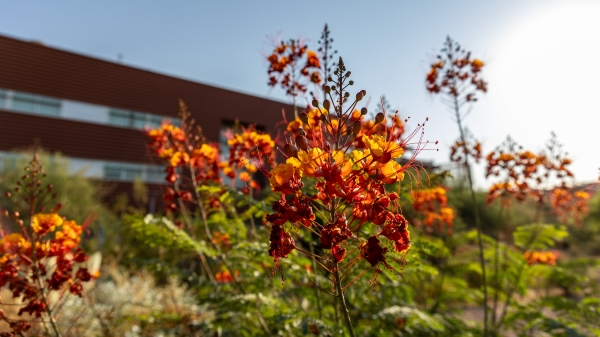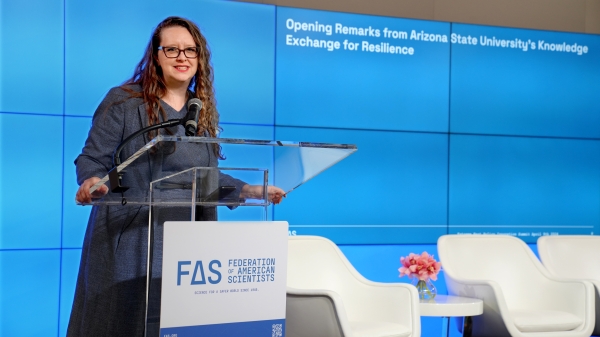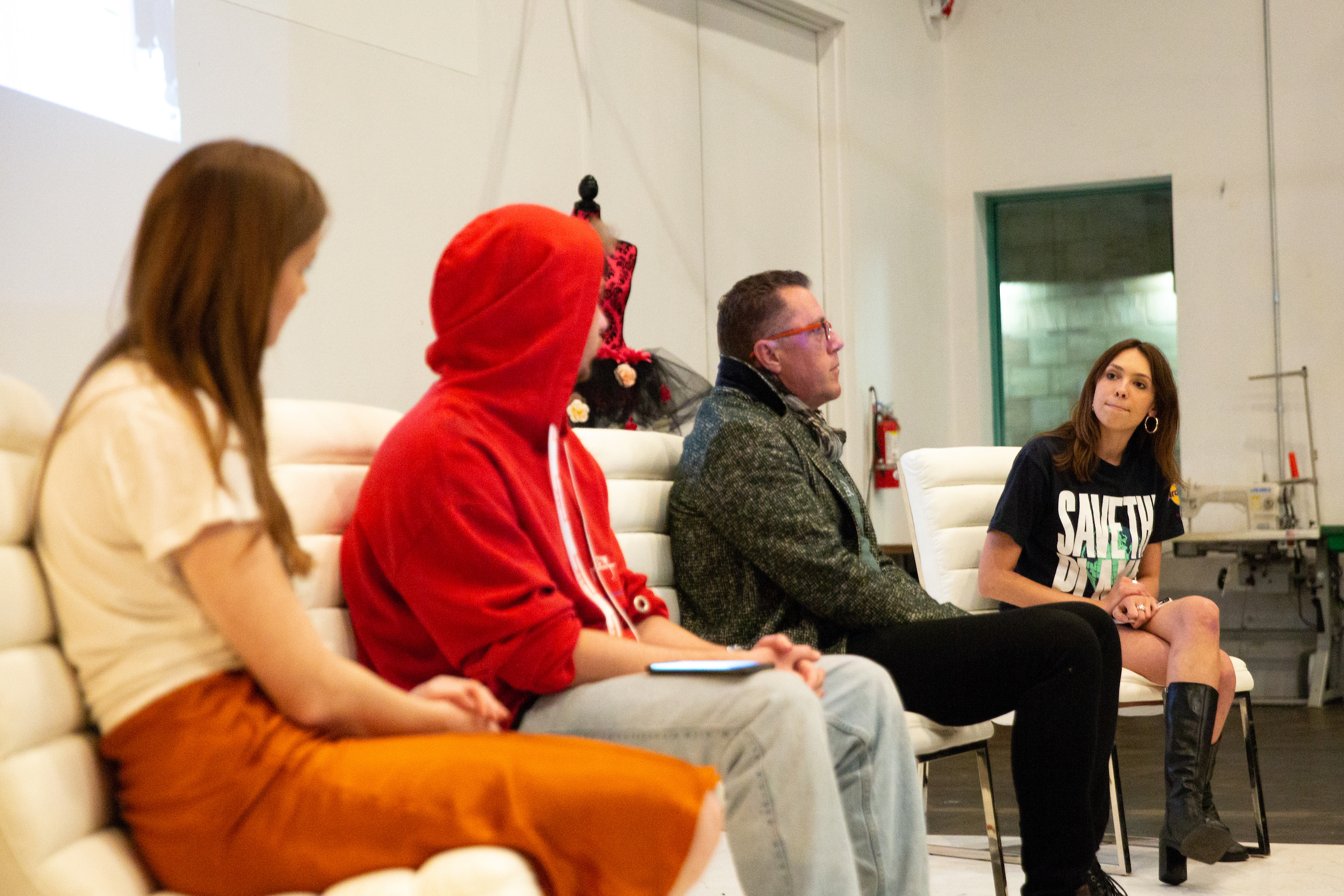Disrupting the closet-to-landfill problem
ASU students, faculty, alumni working on creating a more sustainable fashion industry

January is a time of resolving to improve, and people who want to be more mindful of their effect on their environment are starting to think more about the clothes on their back. The fashion industry, with its global reach, has been highlighted as a driver of pollution.
Many people in the Arizona State University community are examining this issue and thinking of ways to reduce the impact of fashion on the environment. Among the problems:
• Overproduction of clothing is leading to massive waste. Both luxury retailers and “fast fashion” stores have admitted to burning many tons of unsold goods.
• Clothing made of synthetic fibers, such as polyester, is not biodegradable in a landfill and consumes fossil fuels during the manufacturing process. And clothing made of cotton requires the use of pesticides on the crops.
• The process of dyeing textiles can release pollutants into the atmosphere and into groundwater.
According to the United Nations Environment Program: “The fashion industry produces 20% of global wastewater and 10% of global carbon emissions. This is more than all international flights and maritime shipping combined.”
In addition, recent catastrophes like a deadly fire in India last year highlighted the often dangerous conditions facing factory workers in developing countries, where people work long hours for low pay.
One ASU student group that’s considering this issue is the Business of Fashion organization. Kaylah Melendez, a fashion major and the operations director of the group, said the focus this year has been on the supply chain — the entire process of producing an item, from sourcing materials to manufacture to the consumer.
“We’re always trying to promote sustainability and I think it’s because we understand how clothes are made,” she said. The group has held clothing swaps and brought in professionals as speakers.
Melendez believes her fellow students are more attuned to the problems of “fast fashion” — brands that sell vast quantities of cheaply made clothing.
“We really want sustainability to be seen as something serious and not just a trend, and for people to see the morals of the clothes that they’re wearing, which were most likely made in a sweatshop.”
As a fashion major, she learns ways to avoid waste in the design process.
“In any studio class where we’re sewing, we’re always trying to cut down on creating scraps. We’re taught how to lay out the fabric the right way,” she said.
“This fashion program is at a school that’s so sustainably focused, and we’re going to be the people working in the industry in the future, so we can create that change as we go into the field,” she said.
Last fall, the Business of Fashion group held a “Sustainability Night” to highlight problems and solutions in the industry. The event included a “radical fashion” panel and a pop-up shop of resale and sustainable brands.
Connor Damaschi, who spoke on the panel, graduated in 2018 with a degree in painting. While he was at ASU, he became interested in fashion and now designs a streetwear brand called Yellow Zone Limited, using fabric repurposed from old tents, tarps and anything else that would be typically be thrown out.
“Sustainability may seem like an abstract, complex term, but to me it’s a function of social and environmental equity,” he said. “To relate that to the fashion industry, it’s about how we’re buying and how we’re producing.”
As a small business owner, Damaschi has trouble with sourcing.
“It’s hard to source something that is really sustainable. Everyone talked about how bamboo rayon is sustainable, it’s really not. It’s made with solvents that end up in the environment,” he said.
“It’s hard to find fabric that’s sourced ethically and responsibly and it’s difficult financially to justify the resulting price to a consumer.”
The fashion event was held at FABRIC, a fashion incubator in Tempe whose president is Sherry Barry, an ASU MBA alumna. FABRIC stands for "Fashion And Business Resource Innovation Center."
Barry described how the fashion industry became so wasteful.
“In the 1980s and ‘90s, apparel manufacturers went overseas to manufacture products, which they did so they could lower the prices and load up their retail stores with products,” she said.
“If you were a big brand, you just opened up more stores and produced more for the stores.”
But now with online retailing, all that production is creating massive amounts of waste.
“Thirty percent of clothing manufactured every year is never sold and ends up in the landfill or being burned,” she said. “There’s so much extra apparel on the market that right now that it can’t even be given away to third-world countries.
“And because most textiles are not biodegradable, it’s causing huge problems in the environment.”
FABRIC provides several solutions to small design firms who want to be sustainable. For example, many suppliers and manufacturers require a minimum number of orders, which might be too much for a single designer. FABRIC allows designers to make clothing with no minimum. The nonprofit also helps designers with launching and marketing a business, and it holds fashion events throughout the year.
“At FABRIC, we believe that small, responsible, sustainable brands that are making what their clients want — one is ordered, one is made and one is sold — is the future,” Barry said.
“That can be done today and we have the technology to do it efficiently here in Arizona.”
Owner of Eternal Noir Michelle Sasonov (left) talks to Malcom Brea about her jewelry at a sustainable fashion event at FABRIC in Tempe last fall. Photo by Meg Potter/ASU Now
Traceable supply chains
While designers and small firms struggle with sourcing, large companies also have difficulty with their supply chains and the ability to guarantee ethically acquired materials at every step in the process, according to Kevin Dooley, Distinguished Professor of Supply Chain Management in the W. P. Carey School of Business and a senior sustainability scientist in the Julie Ann Wrigley Global Institute of Sustainability. He also is chief scientist of the Sustainability Consortium, where he leads a global research team that works with more than 100 of the world’s largest retailers to track progress on sustainability issues. The consortium’s tools are the basis of the Walmart Sustainability Index.
The supply chain also includes what happens to an item after someone buys it, Dooley said.
“What we tend to think of as the supply chain, where raw materials are harvested or grown or extracted and eventually get a product to market, also includes the use of the product and the end of its life,” he said.
“That whole chain of events has the potential for environmental or social impacts that are negative due to the activities at the various stages.”
Sustainability requires both “traceability” and “transparency,” he said.
“When you know where the yarn for your textile is being produced, then you can identify the social and environmental risk that exists and then you can ask about the state of those suppliers relative to those hot spots,” he said.
Dooley has been involved with developing the Walmart Sustainability Index, which has been operating for five years and has been used by other major retailers, such as Kroger.
“Our supplier surveys enable the product manufacturer to tell their story of how sustainable their consumer products are,” he said.
“Walmart and other retailers make the performance on those sustainability scorecards part of the overall supplier scorecard. Traditionally, they would look at cost and innovation, and they’re now incorporating sustainability in the decision-making.”
Consumers are now demanding this, he said.
“There’s a growing recognition that the end consumer is more interested in sustainable attributes, especially in the food category, and it’s spreading to other categories,” he said.
In general, consumers think of sustainability in terms of “in me, on me and around me.”
“People are most concerned with what they put inside themselves, food and pharmaceuticals,” he said.
“Then ‘on me’ is with beauty and personal care products and to some extent clothing, especially baby clothing. And ‘on me’ also would include things that consumers touch, so that’s why packaging has been an issue.
“And for ‘around me,’ if it’s near me, like whether my refrigerator is efficient and I have to pay out of pocket if it’s not, it’s easier to be concerned than if it’s far away from me, like the North Pole melting.”
Dooley said that improving sustainability in the supply chain doesn’t necessarily have to drive up the price of a product. For example, reducing waste and cutting energy or water usage could save money for a company, and those savings could be passed on to the consumer.
This semester, Dooley is working with his students on Project WearEver, in which they’ll put tiny digital tags into clothing to track where it goes.
“The end goal is to create a system whereby manufacturers who are designing clothing that has better usefulness and longer first lives can have a platform to proclaim that performance,” he said.
#NoNewClothing
One solution to reducing fashion’s impact on the environment has turned into a popular social media hashtag: #NoNewClothing, a challenge to buy only secondhand items — or none at all.
ASU graduate student Annie Hall has lived by that guideline ever since she returned from her two-year Peace Corps stint in Ecuador last year.
“Living in a country where I had fewer resources made me more creative in the way I reused all materials,” said Hall, who’s now pursuing an MBA at ASU.
“Peace Corps volunteers tend to be resourceful — there’s a lot of sharing of clothing and recycling that happens among us. And that’s a priority I wanted to bring back with me.”
Americans are less inclined to embrace the concept of sharing items with friends and family before going out to buy something new, she said. But since she’s returned, she’s been committed to buying secondhand.
“Whether it’s been furniture, clothing or even small household items, sometimes I have to dig a little harder but it’s been worth it to me and I feel better about making those choices,” she said.
Last fall, Hall worked on applying her personal passion to a business idea in the PLuS Alliance Circular Economy ResourCE Hack, which focused on fashion. The team members, Andrew John De Los Santos and Meghan Marrin, both graduate students in the School of Sustainability, and Hall, met through the Net Impact graduate student organization.
“Our idea was essentially a clothing library,” Hall said. “It’s a business where young people or people who need to update their wardrobe can rent business professional and business casual clothing instead of having to buy a new wardrobe.
“For a lot of people, it’s very expensive and it’s also clothing that doesn’t get a lot of use and sits in peoples’ closets. People need to dress professionally to go on interviews but not necessarily in their everyday job.”
Hall herself wants to pursue a career in sustainable fashion design. She worked for two years as a designer at Nestor Hosiery, a small manufacturer of performance socks based in North Carolina that prioritized sustainability.
“My goal would be to create clothing that is sourced out of the postconsumer waste stream,” she said.
“But I wouldn’t do it in the traditional recycling sense of taking a bunch of fabric and trying to shred it and make a product. I want to focus on keeping the fabric in as close to the original form as possible, and using damaged or torn or stained pieces — the type of pieces that are thrown away — that with creativity can be repurposed into a unique garment.”
Hall’s team, which won the ASU contest, didn’t win the grand prize in competition with UNSW Sydney, King's College London and Tec de Monterrey. But she found the experience valuable.
“It opened my mind to not only the opportunities for creating a sustainable business but also how much interest there is from the world at large in supporting sustainability,” she said.
Sophia Toomb (at far right) moderated a panel devoted to "radical fashion" at the sustainable fashion event at FABRIC in Tempe last fall. Toomb, an ASU alum, has started a website devoted to sustainable fashion. From left are designer Eartha Hubbell, fashion designer and ASU alumn Connor Damaschi and Herman Plank, an expert on plastics. Photo by Meg Potter/ASU Now
Sustainable brands
Sophia Toomb has been passionate about sustainable fashion since her freshman year, when she joined the Business of Fashion group. A 2019 graduate with a degree in supply chain management, she wrote her honors thesis on the “circular” supply chain of the fashion resale industry — when items are kept in circulation rather than ending up in a landfill.
“Sustainable fashion has been the biggest passion in my life and I try to do everything I can to make sure I shop consciously,” she said.
Toomb has seen the industry from different angles. She worked at the resale store Buffalo Exchange in Tempe while a student and is now an assistant buyer for a department store. She believes consumer demand is driving major brands to make changes.
“There are so many retailers that are starting to source more sustainable brands or brands that are more fair trade or use more sustainable fabric content,” she said.
Toomb sees two ways that consumers can promote sustainability: Don’t buy new clothing, but if you do, consider brands that are committed to sustainability.
“My biggest recommendation is to shop secondhand. You can find so many current styles, designers and even clothes with the tags still on them at secondhand stores,” she said.
“It’s cheaper, more sustainable and you’re buying something that’s already in the system.”
She likes Buffalo Exchange and Goodwill, plus the web sites The RealReal and ThredUp.
But for people not inclined to buy used clothing, she supports brands that are working to be kinder to the environment.
“Do your research and see what steps they’re taking,” she said.
Toomb recently launched a web site called Moda Verde that curates sustainable brands. Some retailers on her site make clothing out of recycled water bottles or repurposed scraps of fabric.
“I think there are more and more sustainable designers emerging and that will continue,” she said. “But you have to do your research and that’s why I created my website. I curate the brands and do the research.”
Toomb wants consumers to consider the environment when they acquire clothing.
“I hope everyone recognizes that the planet is at stake, honestly,” she said.
Top image: A sustainable fashion event held last fall by two student groups, Business of Fashion and Sun Devils for Fair Trade, featured a pop-up shop of vintage clothes at FABRIC in Tempe. Photo by Meg Potter/ASU Now
More Environment and sustainability

Barrett Honors College to host nature walks for science, relaxation
Barrett, The Honors College at Arizona State University is gearing up to participate in the City Nature Challenge (CNC) for the fourth consecutive year. This annual event, taking place April 26–29,…

Arizona adapting to heat crisis with initiatives featured in ASU report
Arizona State University's Knowledge Exchange for Resilience, also known as KER, released its Recommendations Report on Extreme Heat Preparedness earlier this April during a summit in the nation's…

Celebrating Earth Day around the world
Originating in the United States in 1970, Earth Day is now celebrated worldwide. But even before it became an official day, many countries were already mindful of their carbon footprint in their…

